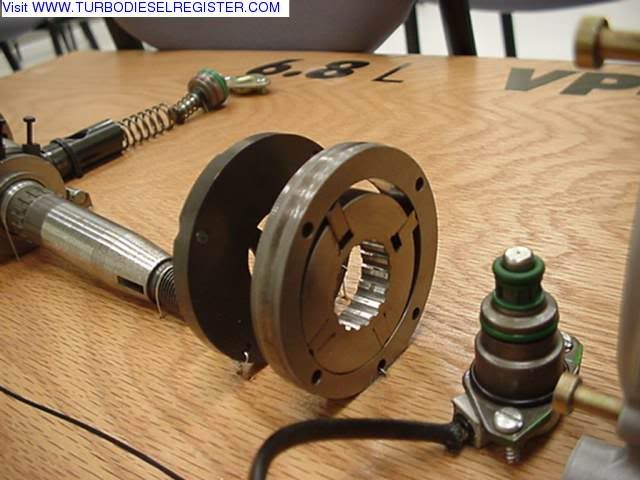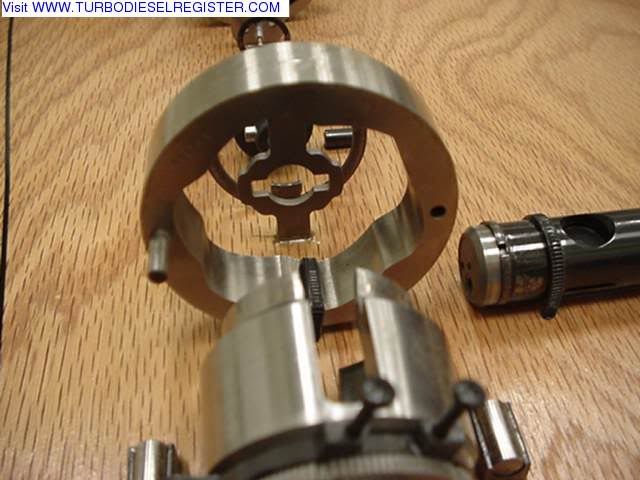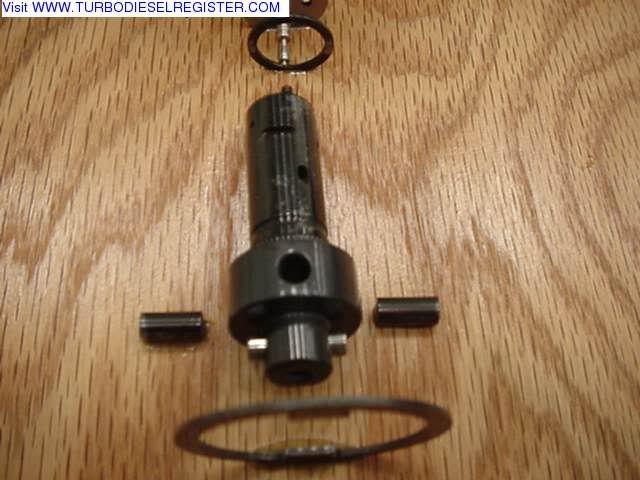VP44 *REBUILD* info
#16
oh yeah there was a section on FAKE HOT ROD PUMPS...... if you have a so called hot rod pump there are people taking stock pumps wiring extrea resistors in the circuit to alter the sensor signals and causing them to work harder then a actual built pump for high horsepower......dont get scammed by this... if you are looking for a hot rod pump ask them a few questions in the building of it.. see what they have to say about it.
#17
You CAN NOT simply replace the PSG and run the pump down the road.
Storx, you need to read the whole book and calibration procedures before you start making claims. Some parameters must be set on the teststand before the pump is even completely assembled. Then after pump is calibrate you need to set start of delivery blocking.
There is a host of parts prices that you did not put down. Housings, timing pistons, driveshafts,supply pump,etc. these are parts you must stock. Calibration equipment, programs, special tools,and you haven't scratched the surface
But hey if someone wants to buy a halfased pump go ahead.
And not all hot rod pumps are simply a resistor addition. There are other things to be done, but you can figure that out.
Storx, you need to read the whole book and calibration procedures before you start making claims. Some parameters must be set on the teststand before the pump is even completely assembled. Then after pump is calibrate you need to set start of delivery blocking.
There is a host of parts prices that you did not put down. Housings, timing pistons, driveshafts,supply pump,etc. these are parts you must stock. Calibration equipment, programs, special tools,and you haven't scratched the surface
But hey if someone wants to buy a halfased pump go ahead.
And not all hot rod pumps are simply a resistor addition. There are other things to be done, but you can figure that out.
#18
like most things with high tolerances it takes more than the average tool box contents to fix it, storx I think you had good intentions but the ability to warranty and back up your work will need a major investment in equipment, and even if your military shop has all the need tools somthing tells me uncle sam may not like you supplementing your miltary income after work in their shop.
#19
If VP44 pumps are like other high pressure pumps, you don't need all the parts.
I am in the coatings industry (ya, a far cry from diesel mech. , but a high pressure pump is a high pressure pump), and it's usually the same parts that fail, and even though they require you to buy a whole kit just to get the part you need, you also know that years down the road the same part will usually fail once again, and you will be buying the whole kit and installing it once again.
I had a problem with one mfgr. wanting about 150.00 just for a carbide flap for a valve for a high pressure pump that quit sealing. A non-repairablle part. Supposedly.
I had some diamond paste laying around, so I made a jig, spun it on a granite flat piece for 20 minutes OUT OF CURIOSITY ONLY, and re-installed it. Guess what, it was fixed. And since it was mine, ...I left it intact to see what would happen. To this day it is still fine. It would have cost me more time just to aquire the correct part (not including the money) that it did for me to have it running again.
Diesel is not hard on parts compared to coatings. I suspect it is a minority of parts that wear and fail, and usually the same ones... Although I'll be the first to admit that I don't have a schematic or tech. drawing of a VP44 (I sure wish I did, the curiousity is killing me. I wish someone would give me a dead one to tinker with, but the core's are expensive.
I am in the coatings industry (ya, a far cry from diesel mech. , but a high pressure pump is a high pressure pump), and it's usually the same parts that fail, and even though they require you to buy a whole kit just to get the part you need, you also know that years down the road the same part will usually fail once again, and you will be buying the whole kit and installing it once again.
I had a problem with one mfgr. wanting about 150.00 just for a carbide flap for a valve for a high pressure pump that quit sealing. A non-repairablle part. Supposedly.
I had some diamond paste laying around, so I made a jig, spun it on a granite flat piece for 20 minutes OUT OF CURIOSITY ONLY, and re-installed it. Guess what, it was fixed. And since it was mine, ...I left it intact to see what would happen. To this day it is still fine. It would have cost me more time just to aquire the correct part (not including the money) that it did for me to have it running again.
Diesel is not hard on parts compared to coatings. I suspect it is a minority of parts that wear and fail, and usually the same ones... Although I'll be the first to admit that I don't have a schematic or tech. drawing of a VP44 (I sure wish I did, the curiousity is killing me. I wish someone would give me a dead one to tinker with, but the core's are expensive.
#20
i have stated over and over that i have not yet looked fully in the book or taken the class yet. If you feel the need to try to bust my ***** then go bust your own ***** for being to **** lazy to read the entire post. I said i was going to offer this AFTER i sent to the school and was certified by bosch....... If you just want to be rude with me then dont read my post and dont make any comments on my post. Thanks for your 2 cents..... have a nice day...
#21
I, for one, quite liked your post.
I hope I didn't sound like I was busting your *****. I wished I was younger, etc., so I could do the same thing you would like to do. One thing for sure, you'll always have business if you do a top notch job at a very competetive price.
I apologize for everybody else busting your ***** too. Many people out there (probably some of them members of this site) have a personal interest in the price of a rebuild on a VP44 not coming down too much,... you would be pissing in their collective wheaties.
Have a nice day.
I hope I didn't sound like I was busting your *****. I wished I was younger, etc., so I could do the same thing you would like to do. One thing for sure, you'll always have business if you do a top notch job at a very competetive price.
I apologize for everybody else busting your ***** too. Many people out there (probably some of them members of this site) have a personal interest in the price of a rebuild on a VP44 not coming down too much,... you would be pissing in their collective wheaties.
Have a nice day.
#22
Puke... Just for you...
http://www.turbodieselregister.com/u...&albumid=17275
http://www.turbodieselregister.com/u...&albumid=17275
#23
Those pictures were cool. I don't belong to them anymore so I don't go there much.
I hear the vp44 is a diaphram pump, but I didn't see a diaphram sitting there anywhere, Maybe it's much smaller, in the coatings industry, one an inch across can pump 120 gph at 3500 psi and not even flinch., But someone told me the the vp44 goes to 4000 psi or something like that.
It looks to me like the complicated part is the six lines going out///Can I be correct in assuming that they have to be "timed"???? by the vp44??? or the ecu or something??
I was looking through there but I didn't see electronics either, I know it's supposed to have some electronics in there also.
Thanx a bunch for the post. I need to figure out how to save them to my hard drive.
Is there a technical diagram of that pump (or is it proprietary to bosch???).
Thanx
I hear the vp44 is a diaphram pump, but I didn't see a diaphram sitting there anywhere, Maybe it's much smaller, in the coatings industry, one an inch across can pump 120 gph at 3500 psi and not even flinch., But someone told me the the vp44 goes to 4000 psi or something like that.
It looks to me like the complicated part is the six lines going out///Can I be correct in assuming that they have to be "timed"???? by the vp44??? or the ecu or something??
I was looking through there but I didn't see electronics either, I know it's supposed to have some electronics in there also.
Thanx a bunch for the post. I need to figure out how to save them to my hard drive.
Is there a technical diagram of that pump (or is it proprietary to bosch???).
Thanx
#24
Originally Posted by storx
i have stated over and over that i have not yet looked fully in the book or taken the class yet. If you feel the need to try to bust my ***** then go bust your own ***** for being to **** lazy to read the entire post. I said i was going to offer this AFTER i sent to the school and was certified by bosch....... If you just want to be rude with me then dont read my post and dont make any comments on my post. Thanks for your 2 cents..... have a nice day...
If these pumps could be easily fixed someone would have figured it out by know we have some very smart pepople on this board.
#25
I thought that the output pressure from the VP pump was around the 15000psi range. Most injectors have a pop-off pressure ranging from 11000 to 15000 psi. I have a dumb question, so how do you get the pump to shot in more fuel. I'm guessing that the injector will start to flow as the piston comes to TDC. This is think is what everyone refers to advance. The more your advance your pump is the longer that your injector flows fuel, I think. I always that these pumps where like a hydrostatic pump, with 6 little pistons and a plate that varied the amount of fuel being displaced. I guess that it all comes down to how you can get the job done at the cheapest prices. I might have to rip one of these pumps apart. A core is a core regardless, unless you smash it. 

#26
I would be quite surprised if it was that high (although it might be).
Most high pressure pumps in the industry top out at under 5,000 psi because the equiment, lines, fittings, etc, are usually rated a little over 5,000 psi. But I don't have experience with injection systems for diesels...per se, so I don't know. It's an interesting discussion.
I know they make stuff that goes up to 80,000 psi, but that stuff is out of my league, we don't use it. I think it is for the people who fabricate marble and granite.
Most high pressure pumps in the industry top out at under 5,000 psi because the equiment, lines, fittings, etc, are usually rated a little over 5,000 psi. But I don't have experience with injection systems for diesels...per se, so I don't know. It's an interesting discussion.
I know they make stuff that goes up to 80,000 psi, but that stuff is out of my league, we don't use it. I think it is for the people who fabricate marble and granite.
#27
The VP44 produces a peak injection pressure of over 23,000 PSI at the injector in stock form!!!
Typically the injectors mechanical nozzle opening pressure is 4400-4500 PSI.
Compared to the old P pumps that barely manage 17,000 PSI peak.
Don~
Typically the injectors mechanical nozzle opening pressure is 4400-4500 PSI.
Compared to the old P pumps that barely manage 17,000 PSI peak.
Don~
#28
Do you mean "capable of producing? or is that the pressure inside the line after the injector opens????
How big are the orfices (or nozzles, or whatever you call them) on a standard injector??? They must be awfully small if they are to pop off at 4k but the line will still have 20K pressure in it. Even a .004 hole would be dumping a couple quarts of diesel every couple minutes into each cylinder at 20K pressure..woudn't it.
If the injector opens at 4,000 psi, , then won't everything past 4000 psi be bled into the cylinder??? That hole has got to be awfully small. DOesn't it.
By the way, Why such high pressure, you get a fairly good atomized spurt with just a few thousand pounds.
This is a very interesting discussion. I am learning a lot.
How big are the orfices (or nozzles, or whatever you call them) on a standard injector??? They must be awfully small if they are to pop off at 4k but the line will still have 20K pressure in it. Even a .004 hole would be dumping a couple quarts of diesel every couple minutes into each cylinder at 20K pressure..woudn't it.
If the injector opens at 4,000 psi, , then won't everything past 4000 psi be bled into the cylinder??? That hole has got to be awfully small. DOesn't it.
By the way, Why such high pressure, you get a fairly good atomized spurt with just a few thousand pounds.
This is a very interesting discussion. I am learning a lot.
#29
The charge pump is basically a vane type pump... Its pressure also moves the timing plunger..

The electronics are mounted in the top portion of the pump.. you can see the bottom side of the electronic housing.. with the timing ring sensor hanging loose.. There is also a fuel temp sensor inside the housing.. fuel runs on the bottem side of the housing.. theory is to help keep the electronics cool..



The high pressure pump is a basic rotory pump with two rollers running on the cam ring.. the trick part of the VP pump is its ability to move the cam ring.. which can change the timing... it can also change its timing by keeping the spill port open as the roller starts traveling up the ramp of the cam ring. (as the roller goes up the cam ring it is pushing the plungers in) The really cool thing about the VP pump, is that it can cut out a cylinder if told to by the ECU.. (For Diagnostic by a Tech)
Basically when the roller is traveling down the ramp of the ring.. its in its Fill cycle.. as it starts up the ramp the solenoid can stay open "spilling" out fuel.. then it closes forcing the fuel to go out the port to the delievery valve.. When the ECU things that's enough fuel, the solenoid opens, and we have spill again.. the roller crest the top of the lobe on the ring and starts down on the fill cycle again..
When you tap the wire with a box, it is changing the duration that the solenoid that forces the fuel to the injection lines.. Timing can be changed either by moving the Cam ring.. and/or changing the event as it travels up the ramp..

The electronics are mounted in the top portion of the pump.. you can see the bottom side of the electronic housing.. with the timing ring sensor hanging loose.. There is also a fuel temp sensor inside the housing.. fuel runs on the bottem side of the housing.. theory is to help keep the electronics cool..



The high pressure pump is a basic rotory pump with two rollers running on the cam ring.. the trick part of the VP pump is its ability to move the cam ring.. which can change the timing... it can also change its timing by keeping the spill port open as the roller starts traveling up the ramp of the cam ring. (as the roller goes up the cam ring it is pushing the plungers in) The really cool thing about the VP pump, is that it can cut out a cylinder if told to by the ECU.. (For Diagnostic by a Tech)
Basically when the roller is traveling down the ramp of the ring.. its in its Fill cycle.. as it starts up the ramp the solenoid can stay open "spilling" out fuel.. then it closes forcing the fuel to go out the port to the delievery valve.. When the ECU things that's enough fuel, the solenoid opens, and we have spill again.. the roller crest the top of the lobe on the ring and starts down on the fill cycle again..
When you tap the wire with a box, it is changing the duration that the solenoid that forces the fuel to the injection lines.. Timing can be changed either by moving the Cam ring.. and/or changing the event as it travels up the ramp..


